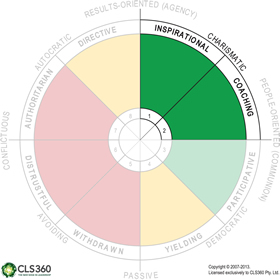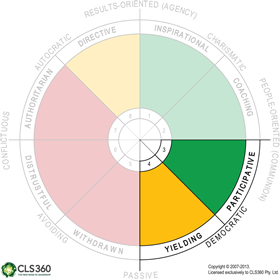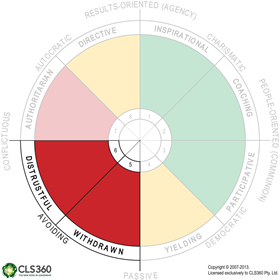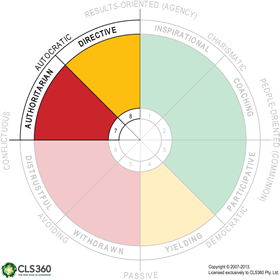Quadrants & Styles
The CLS360 has four leadership quadrants: Charismatic, Democratic, Avoiding, and Autocratic.
 Charismatic Quadrant
Charismatic Quadrant
Referred to as transformational styles, Inspirational and Coaching are associated with an interest in higher goals; warmth and the ability to enroll others; motivating, intellectually stimulating, and showing consideration to others. These styles correlate the most with employee satisfaction and motivation, employee effort, and leader effectiveness based on organisational performance criteria and performance appraisals by upper management.
1. Inspirational Style
Leaders inspire and stimulate others by self-assured action, courage, and clear messages.
Inspirational behaviours include the following:
- Clearly communicating the vision (the 'what' and the 'why')
- Giving clear instructions if the situation requires
- Acting decisively when performance and/or organisational problems arise
- Clearly leading people and conversations
- Intellectual stimulation, for example, by challenging procedures or the status-quo
2. Coaching Style
Leaders pay attention to and spend time with employees, making this the most preferred leadership style by employees.
Coaching behaviours include the following:
- Helping employees in the short term; developing employees in the long term
- Involving employees in the work and giving them a chance to take initiative
- Making time for employees, for example, talking about the job or about their development
- Mediating conflict situations
- Being open to others' ideas and feedback
 Democratic Quadrant
Democratic Quadrant
The leader frequently involves employees in discussions and decision making. The leader supervises from a distance, monitors the results, and only takes action when necessary. Leadership researchers refer to these styles as ‘leadership by exception—active.’ However, this is only effective if standards and direction have been set in advance, which requires behaviours that are characteristic of the Inspirational and Directive styles. The Participative style consistently correlates positively with leader and employee satisfaction, superior group decision making, and low stress.
3. Participative Style
Leaders involve team members in decision-making processes, easily accept and incorporate employees’ suggestions, and show they understand the feelings of employees. This leadership style is often referred to as an empowering style.
Participative behaviours include the following:
- Being modest, calm, and patient
- Asking for and listening to the opinions of employees
- Drawing employees into the decision-making process
- Giving employees space to carry out their tasks
- Facilitating group discussions
4. Yielding Style
Leaders are very flexible when interacting with employees, sometimes providing insufficient guidance and direction. The Yielding style may be appropriate when employees are very experienced and self-directed, or in rare situations when employees need flexibility, for example, having a sick child. However, overuse of this style will jeopardise long-term effectiveness.
Yielding behaviours include the following:
- Trying to please employees (sometimes too much)
- Occasionally allowing employees to take the lead
- Avoiding being the centre of attention
- Being too flexible with standards and rules
- Not addressing big problems
 Avoiding Quadrant
Avoiding Quadrant
Overall, this is ʻnon-leadershipʼ or the avoidance of responsibility by the leader. The leader that uses these styles—certainly in the eyes of employees—takes action too late, or when the problems have already become serious.
5. Withdrawn Style
Leaders are personally and professionally absent and lacking courage. This style leads to de-motivation and causes employees to feel somewhat lost.
Withdrawn behaviours include the following:
- Not offering clarity, transparency, or direction
- Being unavailable and leaving employees needing help to their fate
- Hesitating to express preferences
- Putting off making decisions
- Allowing tensions and problems to drag on
6. Distrustful Style
Leaders intervene too late in team or other operational conflicts, and are often suspicious of the motives of employees. The leader is negative, hesitant, and often very unclear about what he or she wants, and about the direction to be followed.
Distrustful behaviours include the following:
- Deliberately being unclear; holding back (important) information, and hiding intentions
- Judging others quickly and in a negative way
- Being undecided and anxious
- Maintaining a generally hostile attitude
- Showing distrust in employees' initiatives or proposals
 Autocratic Quadrant
Autocratic Quadrant
Leaders who use these styles hope to enforce obedience or compliance in their employees. They communicate in a cold, distant, harsh, or one-sided manner—without showing much understanding for others.
7. Authoritarian Style
Leaders use force, are hostile, and are ‘against’ others. They present things in a one-sided and unpleasant way. This style is often associated with anger in all its gradations—irritation, annoyance, impatience, fury.
Authoritarian behaviours include the following:
- Dominating, dictating, and not tolerating participation
- Threatening with sanctions
- Attacking in a cold and hard manner
- Often showing irritation and anger
- Unilaterally imposing performance levels, for example, objectives and goals
8. Directive Style
Leaders are very dominant and clear about what they want done. They actively monitor and correct employees, referring often to rules and regulations. They try to reach personal success in a competitive manner—at least in the eyes of others.
Directive behaviours include the following:
- Controlling and demanding compliance
- Communicating exclusively the 'what' without the 'why'
- Seeking status, power, and personal gain
- Being extremely competitive and very results oriented
- Being preoccupied with one’s own career; aiming for personal success